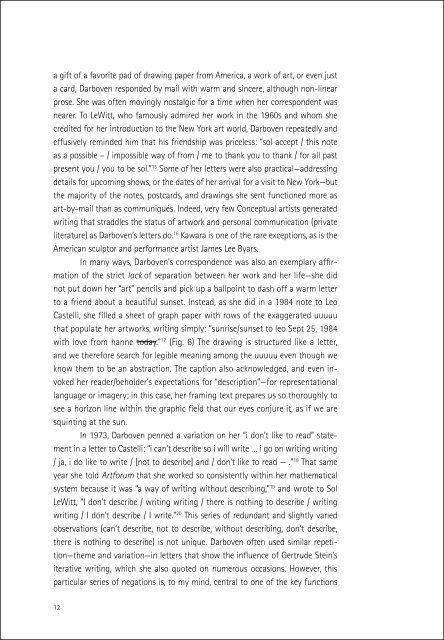Hanne Darboven
Darbovenweb
Darbovenweb
You also want an ePaper? Increase the reach of your titles
YUMPU automatically turns print PDFs into web optimized ePapers that Google loves.
a gift of a favorite pad of drawing paper from America, a work of art, or even just<br />
a card, <strong>Darboven</strong> responded by mail with warm and sincere, although non-linear<br />
prose. She was often movingly nostalgic for a time when her correspondent was<br />
nearer. To LeWitt, who famously admired her work in the 1960s and whom she<br />
credited for her introduction to the New York art world, <strong>Darboven</strong> repeatedly and<br />
effusively reminded him that his friendship was priceless: “sol accept / this note<br />
as a possible – / impossible way of from / me to thank you to thank / for all past<br />
present you / you to be sol.” 15 Some of her letters were also practical—addressing<br />
details for upcoming shows, or the dates of her arrival for a visit to New York—but<br />
the majority of the notes, postcards, and drawings she sent functioned more as<br />
art-by-mail than as communiqués. Indeed, very few Conceptual artists generated<br />
writing that straddles the status of artwork and personal communication (private<br />
literature) as <strong>Darboven</strong>’s letters do. 16 Kawara is one of the rare exceptions, as is the<br />
American sculptor and performance artist James Lee Byars.<br />
In many ways, <strong>Darboven</strong>’s correspondence was also an exemplary affirmation<br />
of the strict lack of separation between her work and her life—she did<br />
not put down her “art” pencils and pick up a ballpoint to dash off a warm letter<br />
to a friend about a beautiful sunset. Instead, as she did in a 1984 note to Leo<br />
Castelli, she filled a sheet of graph paper with rows of the exaggerated uuuuu<br />
that populate her artworks, writing simply: “sunrise/sunset to leo Sept 25, 1984<br />
with love from hanne today.” 17 (Fig. 6) The drawing is structured like a letter,<br />
and we therefore search for legible meaning among the uuuuu even though we<br />
know them to be an abstraction. The caption also acknowledged, and even invoked<br />
her reader/beholder’s expectations for “description”—for representational<br />
language or imagery; in this case, her framing text prepares us so thoroughly to<br />
see a horizon line within the graphic field that our eyes conjure it, as if we are<br />
squinting at the sun.<br />
In 1973, <strong>Darboven</strong> penned a variation on her “i don’t like to read” statement<br />
in a letter to Castelli: “i can’t describe so i will write … i go on writing writing<br />
/ ja, i do like to write / [not to describe] and / don’t like to read — .” 18 That same<br />
year she told Artforum that she worked so consistently within her mathematical<br />
system because it was “a way of writing without describing,” 19 and wrote to Sol<br />
LeWitt, “I don’t describe / writing writing / there is nothing to describe / writing<br />
writing / I don’t describe / I write.” 20 This series of redundant and slightly varied<br />
observations (can’t describe, not to describe, without describing, don’t describe,<br />
there is nothing to describe) is not unique. <strong>Darboven</strong> often used similar repetition—theme<br />
and variation—in letters that show the influence of Gertrude Stein’s<br />
iterative writing, which she also quoted on numerous occasions. However, this<br />
particular series of negations is, to my mind, central to one of the key functions<br />
12


